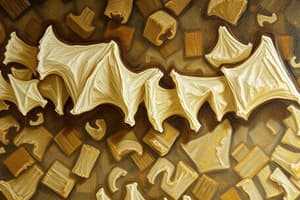Podcast
Questions and Answers
What is the primary process involved in pyrolysis?
What is the primary process involved in pyrolysis?
- Chemical synthesis using catalysts
- Thermal decomposition in an oxygen-free atmosphere (correct)
- Absorption of moisture at high temperatures
- Decomposition in the presence of oxygen
The acetylation process replaces hydroxyl groups in cellulose with hydrogen atoms.
The acetylation process replaces hydroxyl groups in cellulose with hydrogen atoms.
False (B)
What is the chemical formula of Acetate Compound Propionate (CAP)?
What is the chemical formula of Acetate Compound Propionate (CAP)?
C76H114O49
Cellulose acetate can be dissolved in certain solvents or ______ under heat.
Cellulose acetate can be dissolved in certain solvents or ______ under heat.
Match the following properties with their corresponding acetate compounds:
Match the following properties with their corresponding acetate compounds:
What types of applications are suitable for Acetate Compound Butyrate?
What types of applications are suitable for Acetate Compound Butyrate?
Acetate compounds are not suitable for use in the paint industry.
Acetate compounds are not suitable for use in the paint industry.
The acetylation of cellulose results in the formation of ______, allowing the material to be spun into fibers.
The acetylation of cellulose results in the formation of ______, allowing the material to be spun into fibers.
What type of bonds connect the glucose units in cellulose?
What type of bonds connect the glucose units in cellulose?
Cellulose is soluble in water.
Cellulose is soluble in water.
What is the primary reason humans cannot digest cellulose?
What is the primary reason humans cannot digest cellulose?
Monomers are small molecules which may be joined together to form __________.
Monomers are small molecules which may be joined together to form __________.
Which of the following best describes cellulose microfibrils?
Which of the following best describes cellulose microfibrils?
Match the types of sugars with their descriptions:
Match the types of sugars with their descriptions:
Cellulolysis refers to the process of cellulose synthesis.
Cellulolysis refers to the process of cellulose synthesis.
Which sugar forms the basis of cellulose?
Which sugar forms the basis of cellulose?
Cellulose is the most abundant organic molecule on Earth.
Cellulose is the most abundant organic molecule on Earth.
What is the main monomer that composes cellulose?
What is the main monomer that composes cellulose?
Cellulose is synthesized at the __________ and organized into microfibrils.
Cellulose is synthesized at the __________ and organized into microfibrils.
What distinguishes alpha glucose from beta glucose?
What distinguishes alpha glucose from beta glucose?
Match the type of enzyme with its function in cellulose degradation:
Match the type of enzyme with its function in cellulose degradation:
What kind of bond links glucose molecules in cellulose?
What kind of bond links glucose molecules in cellulose?
What are the intermediate units formed from cellulose?
What are the intermediate units formed from cellulose?
Cells can only degrade cellulose through hydrolysis and not by microbial activity.
Cells can only degrade cellulose through hydrolysis and not by microbial activity.
What is the primary chemical formula for Carboxymethyl cellulose?
What is the primary chemical formula for Carboxymethyl cellulose?
Acetate Compound Butyrate (CAB) is not soluble in a wide range of solvents.
Acetate Compound Butyrate (CAB) is not soluble in a wide range of solvents.
What are the two types of groups present in Carboxymethyl cellulose?
What are the two types of groups present in Carboxymethyl cellulose?
Ethyl cellulose is used mainly as a __________ coating material.
Ethyl cellulose is used mainly as a __________ coating material.
Match the following cellulose derivatives with their characteristics:
Match the following cellulose derivatives with their characteristics:
Which property is NOT associated with Acetate Compound Butyrate?
Which property is NOT associated with Acetate Compound Butyrate?
Carboxymethyl cellulose is used only in food products.
Carboxymethyl cellulose is used only in food products.
What are two common uses for Carboxymethyl cellulose (CMC)?
What are two common uses for Carboxymethyl cellulose (CMC)?
What characteristic is enhanced by the presence of extractives in wood?
What characteristic is enhanced by the presence of extractives in wood?
Tyloses are beneficial for all applications of wood.
Tyloses are beneficial for all applications of wood.
What are tyloses?
What are tyloses?
The presence of extractives in certain types of wood can make them emit a __________ odor.
The presence of extractives in certain types of wood can make them emit a __________ odor.
Match the following wood characteristics with their effects:
Match the following wood characteristics with their effects:
Which tree species is known for having abundant tyloses?
Which tree species is known for having abundant tyloses?
Extractives block intercellular spaces, reducing permeability in wood.
Extractives block intercellular spaces, reducing permeability in wood.
How do crystals in wood help with identification?
How do crystals in wood help with identification?
Flashcards are hidden until you start studying
Study Notes
Polymers and Monomers
- Monomers are single molecules that can join to form complex polymers.
- Polymers consist of many repeating monomer units and can be natural or synthetic.
Cellulose
- Most abundant organic molecule due to its presence in plant cell walls and slow decay.
- Made of unbranched chains of β-D-glucose units connected by β-1,4-glycosidic bonds.
- Insoluble in water; cannot be digested by humans due to inability to break down β-1,4-glycosidic bonds.
Types of Sugars (Carbohydrates)
- Monosaccharides: Single sugar molecules (e.g., Glucose, Fructose).
- Disaccharides: Two sugar molecules linked (e.g., Sucrose, Maltose).
- Polysaccharides: Long chains of monosaccharides (e.g., Cellulose, Starch).
Alpha vs Beta Glucose
- Alpha glucose: Hydroxyl groups on the same side.
- Beta glucose: Hydroxyl groups on opposite sides.
Formation and Structure of Cellulose
- Synthesized at plasma membrane and organized into microfibrils.
- Cellulose fibers are formed from combined microfibrils, each 5–12 mm wide and consisting of 20–40 chains.
- Contains at least 500 β-D-glucose units linked by β-1,4-glycosidic bonds.
Cellulose Reactions
- Cellulolysis: Degradation of cellulose via hydrolysis, microbial decomposition, and heat.
- Hydrolysis occurs primarily in acid-based solutions.
Intermediate Units from Cellulose
- Cellobiose: Two glucose molecules linked (e.g., Maltose).
- Cellotriose: Three glucose molecules linked.
- Cellotetraose: Four glucose molecules linked.
Enzymatic Breakdown of Cellulose
- Endocellulases: Break down the crystalline structure to amorphous strands.
- Exocellulases: Hydrolyze chain ends to produce smaller sugars like cellobiose and cellotetraose.
- β-glucosidases: Hydrolyze cellobiose and cellotetraose into glucose.
Cellulose Derivatives
- Acetate Compound: Derived from cellulose acetylation, allowing for solubility and versatility in applications like fiber production.
- Propionate Compound: A cellulose ester substituted with acetyl and propionyl groups, known for excellent solubility and stability.
- Butyrate Compound: A mixed ester with enhanced weather resistance and lower moisture absorption.
- Carboxymethyl cellulose (CMC): A water-soluble cellulose derivative used as a thickener in various industries.
- Ethyl Cellulose (EC): Used primarily as a coating material for paper and pills, as well as a thickener.
Extractives in Wood
- Enhance odor, permeability, durability, and luster of wood.
- Odor: Some woods emit pleasant scents due to extractives, useful in manufacturing specific products.
- Permeability: Extractives can block intercellular spaces, affecting fluid permeability.
- Durability: Increase wood density and resistance to moisture and destructive organisms.
- Luster: Can diminish wood's natural shine.
Tyloses
- Foam-like deposits found within vessels of certain wood species.
- Can block vessels, affecting wood uses; beneficial in whiskey barrel production in certain oak species.
- Influence seasoning and preservation processes.
Crystals in Wood
- Valuable for wood identification, commonly found in axial parenchyma and ray cells.
- Morphological changes in crystal-containing cells can aid in taxonomic classification.
Studying That Suits You
Use AI to generate personalized quizzes and flashcards to suit your learning preferences.




